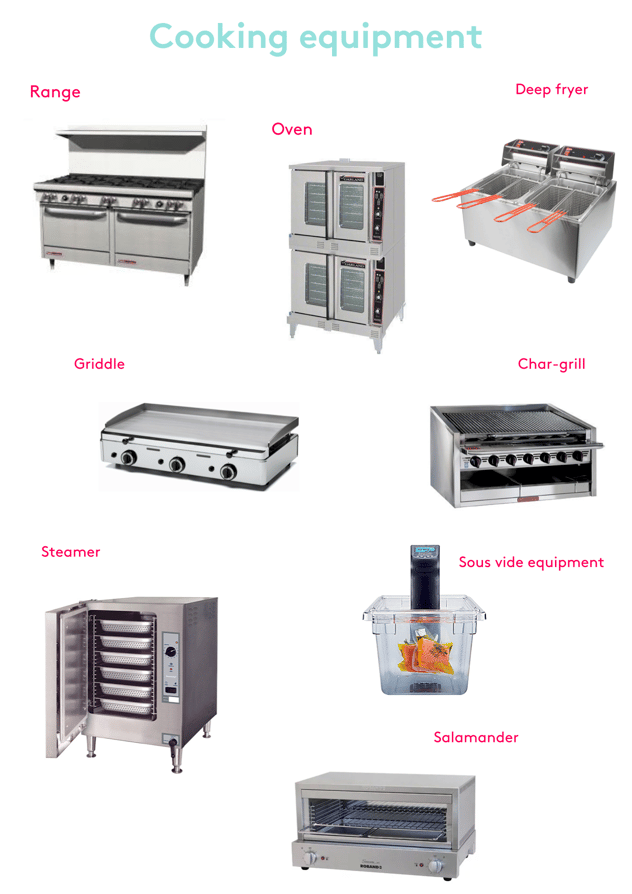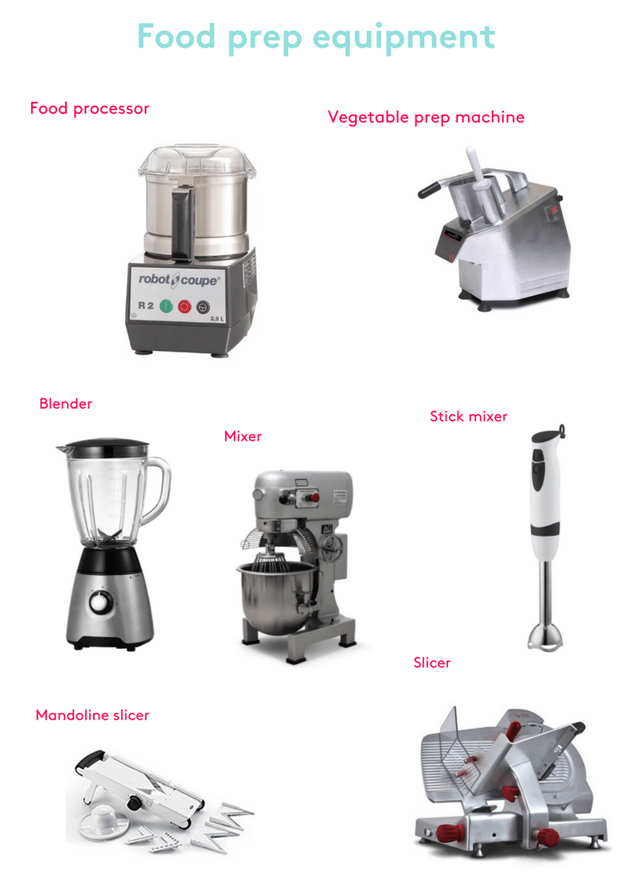One of the biggest investments that goes into opening a new restaurant is the kitchen. A commercial kitchen needs industrial-grade equipment that can withstand busy restaurant use. The layout of a commercial restaurant kitchen must be planned to allow food to flow seamlessly from the prep area to the line.
Sometimes a new restaurant has a fabulous location but a small kitchen space, which dictates the kind of kitchen equipment needed. You may really want the six-burner gas range with a convection oven, but, in reality, your kitchen will only fit a four-burner range. It's important to think strategically about your kitchen well before you sign a lease.
Role of a Restaurant Kitchen
The kitchen is the heart of your restaurant, the place where your menu comes to life. It’s where food is prepared, cooked, and plated. It's the center of the action in many other ways—the kitchen is typically home to the dishwasher, your food ingredients, and all the various utensils, dishes, and cooking equipment.
Unlike in a home kitchen, where it’s just you and your family, a restaurant kitchen can have dozens of people coming and going throughout any given shift, so it’s important that it's organized well. This not only saves time during the busy rushes, but it also helps the staff avoid accidents and reduces excess waste.
Commercial Kitchen Costs
One of the biggest expenses for most new restaurants is the kitchen. A $250,000 loan might seem like a lot of money when you are first getting ready to open, but it can run out quickly after you've invested in new, or even used, ranges, grills, ovens, and coolers.
If you purchase new kitchen equipment, remember that, just as with a new car, these items depreciate the moment they leave the showroom. One way to save money during the startup process is to lease or purchase used kitchen equipment.
Restaurant auctions are a great place to find commercial kitchen equipment for pennies on the dollar. They can be especially helpful for picking up small items like dishware, flatware, bread baskets, condiment containers, and serving utensils. You can also find good deals on gently used kitchen equipment, such as oven ranges and refrigerator units. Just be aware that used equipment doesn't usually come with a warranty. In most cases, this isn't a deal-breaker, but it should be factored into what you're willing to pay.
When shopping for kitchen equipment, remember that salespeople will try to sell you more than you need. While it's tempting to consider every shiny, popular item, you only need a few basics to get you started.
You can always add things later on. So, just walk away from the commercial smoker or the industrial-grade ice cream maker until you are sure smoked ribs and soft serve are integral to your restaurant menu and concept.
Commercial Kitchen Equipment List
Here is a general checklist of everything you need to outfit your restaurant kitchen:
- Range
- Oven
- Grill
- Deep-fryer
- Reach-in cooler
- Walk-in cooler
- Freezer (either a chest, upright, or walk-in)
- Sauté pans
- Stock/soup pots
- Saucepans
- Baking sheets
- Pizza screens
- Baking pans
- Tongs
- Spatulas
- Ladles
- Chef’s knives
- Pizza paddle
- Whisks
- Mixing bowls
- Plastic inserts for coolers
- Steam table
- Entrée plates
- Pasta bowls
- Appetizer plates
- Salad plates
- Dessert plates
- Metal or plastic shelves for walk-in cooler
- Cleaning rags
- Cleaning buckets (specifically labeled for cleaning products)
- Rubber floor mats
- Hand soap and sanitizer dispensers
- Fire extinguisher
Depending on the size of your restaurant kitchen and the restaurant concept, you may not need every item. Or you may need other types of equipment more specific to your restaurant concept, such as an ice cream maker if your restaurant will make artisan ice cream, or bread pans if you plan to make your bread in-house. Be sure you're considering every aspect of your menu plan and kitchen layout as you make your equipment list.
Every commercial kitchen with its unique menu will pick the equipment that will help it meet its food preparation and cooking needs. The equipment used to cook food off a simple brunch menu will look very different to the complicated gadgets used in restaurants that specialize in molecular gastronomy.
With so much different equipment out there, commercial kitchens can be daunting places for back of house newbies – especially those who are working their way up the kitchen hierarchy without a commercial cookery education. That’s why we’ve put together this guide to help you familiarize yourself with some of the equipment you’re likely to come across when you land that back of house job.
Cooking equipment
A range is arguably the most essential piece of equipment in a commercial kitchen. You’d be hard pressed to find a kitchen without one! A range combines a stove with an oven, making it possible to cook food simultaneously in a variety of ways. This includes boiling, frying, pan-searing, baking, broiling and roasting. A small venue may only need a range with two burners while a high-volume venue may use a range with up to 12 burners, preparing a variety of dishes at once.
Commercial ovens come in all shapes and sizes for heating, baking and roasting, ranging from the humble and indispensable microwave to specialized pizza and rotisserie ovens.
Griddles and flat-top grills use a heat source beneath a flat plate which allows food to cook quickly and evenly. They are used to cook a variety of foods, from steaks to pancakes, and are perfect for cooking large quantities of foods at once – which is why you’ll almost always find them in high-volume venues such as diners.
Char-grills (or char-broilers) create the appearance and taste of barbequed foods, making them ideal for cooking meats, especially burgers!

Salamanders (or overhead broilers) are small, self-contained broiler units that can be used for a number of cooking needs, from crisping up the top of a dish to melting cheese and toasting sandwiches.
Deep fryers are another important piece of cooking equipment that you’re likely to come across in many venues. Deep fryers can be used to prepare a variety of foods, from fish and hot chips to donuts. They come in stand-alone or counter-top varieties, with other variations depending on the food preparation needs.
Steamers are used to quickly steam, poach, stew, thaw out or reheat food in what is generally considered a healthier preparation method. Rice cookers and the Bain Marie (used to heat ingredients gently and gradually, or to keep food warm over a period of time) fall into this category.
Sous vide refers to a method of cooking in which food is vacuum-sealed in a plastic pouch and steamed for long periods at low temperatures. You’re likely to come across sous vide cooking if you work in a gourmet restaurant, in which case you’ll become familiar with vacuum packaging machines and vacuum bags.
Food preparation equipment
Food processors have interchangeable blades that speed up the process of repetitive food preparation tasks, especially chopping and grinding. Special vegetable prep models feature a chute through which vegetables are fed for chopping, shredding, grating or julienning.
Blenders are used for emulsifying and liquefying, making them ideal for making sauces, soups and smoothies.
Kneading dough, making cake batter, whipping eggs or preparing cake icing...? A mixer will be your best friend, saving time and potential RSI injuries. Additionally, stick mixers (or immersion blenders) are smaller, hand-held mixers that allow for mixing sauces, soups and stews in the containers in which the food is being prepared. Some models feature a whisk attachment as well.
Slicers are primarily used to cut meats and cheeses (but also many other foods) into thin, uniform slices for perfecting presentation. They can be manually or automatically operated and can even cut frozen foods. Its relative, the mandoline slicer, is used for cutting fruits and vegetables.

Dishwashing equipment
Cleaning and sanitizing dishes in a commercial kitchen is not quite as simple as at home. Every restaurant will feature a deep sink with a hose for rinsing, alongside a commercial-grade dishwashing machine – under-counter or the larger ‘door-type’ (which can feature a conveyor belt), both designed to clean large quantities of dishes at once.
Often you will find separate glass and pot washing machines in a restaurant to accommodate these different needs.
:strip_icc():format(webp)/commercial-kitchen-equipment-checklist-2888867-v7-5ba4fe764cedfd0050db4afa.png)


Comments
Post a Comment